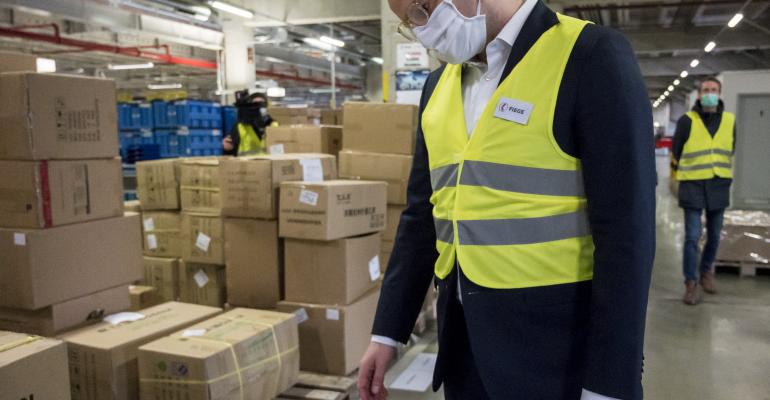While a record number of American workers have been laid off or are working from home, warehouses and e-commerce distribution facilities are beefing up staffing to get groceries and other essential merchandise to consumers.
But what are e-commerce companies and industrial property managers doing to keep their employees safe while they are working in those facilities?
Both Walmart and Amazon announced they have made changes in the way they process orders and in other workplace activities to provide social distancing and prevent the spread of COVID-19 among workers. These changes reportedly include providing a six-foot space between workers processing orders and between furniture in the break rooms.
Walmart and Amazon also say they have implemented enhanced cleaning measures based on guidelines from Centers for Disease Control (CDC) and the World Health Organization (WHO) and are providing workers with protective gear, including gloves, masks, hand sanitizer and disinfectant wipes. The companies report they are doing daily temperature checks before workers enter buildings. Those with a temperature of 100.4 F or higher are sent home and cannot return to work until their temperature is normal for three days, according to both Amazon and Walmart.
Meanwhile, while UPS, Fedex and XPO officials claim their companies are following federal and international guidelines for containing COVID-19, more than 30 of their employees told The New York Times they are worried that their warehouses and trucks had become breeding grounds for the virus.
Some UPS warehouse workers said that supervisors ignored them when they asked for bleach, masks, gloves and hand sanitizer, and hand soap and paper towels were scarce in some of these facilities. Employees also complained of being jammed together along conveyor belts and being subject to the continued ritual of daily security pat-downs. As a result, unionized UPS workers have started an open petition on Change.org demanding hazard pay.
But the warehouse tenants are not the only ones facing the task of keeping properties safe from the virus. Industrial property managers are also grappling with implementing increased cleaning and disinfecting measures to protect tenants, as well as their own staff.
Real estate services firm Transwestern, for example, is following guidelines from the CDC, state and local authorities to keep its property management teams safe, according to Sam Chanin, senior vice president who heads the company’s property management division in Southern California. Specifically, this involves instituting social distancing measures, remote working when possible, deeper cleaning of common areas, and restricting access to buildings exclusively to tenants and essential vendors servicing the property.
In addition, “If our property managers or engineers are within close proximity to tenants or vendors, we follow CDC and state guidelines and ask that everyone wear masks,” Chanin says. “Of course, these instances are limited, as we are following social distancing protocols.
Industrial REIT Prologis has implemented similar measures across its industrial network worldwide, according to the company spokesman. “Wee are following all regulations from government authorities regarding the containment of COVID-19, as well as guidelines set by the World Health Organization, Centers for Disease Control and Prevention and other public health organizations,” he says.
The company provides its employees globally with frequent updates on the latest protocols and procedures with respect to COVID-19 via its intranet. “This includes guidelines regarding the cleaning and disinfection of facilities in the event of a suspected case of COVID-19, as well as guidance to protect the health and safety of our customer experience team members and maintenance technicians.”
So far, no one on Chanin’s management team nor any of the vendors that work in industrial buildings his team manages have tested positive for COVID-19. But despite all the preventive measures put in place by warehouse tenants and landlords, workers are reportedly still getting sick and some of them say more could done to prevent the spread of COVID-19 in the workplace.
For example, a Walmart fulfillment center in Bethlehem, Penn. with 1,800 employees had to temporarily close after some workers tested positive for the virus, so the facility could be cleaned and sanitized, according to the local news station WFMZ-TV.
And another New York Times report claimed that Amazon’s response to the virus came after employees at 50 of its 500 U.S. warehouses tested positive for COVID-19. In mid-March employee attendance at Amazon warehouses dropped by about 30 percent.
Workers at Amazon’s Staten Island, N.Y. fulfillment center, where Amazon reported one case of the virus, walked out on March 30 to protest the company’s response to COVID-19 infections. Workers claimed there had been at least 10 cases at the facility and the company failed to inform them or clean the warehouse properly, according to The Verge. They demanded free testing for COVID-19 and that the facility be shutdown for two weeks for deep cleaning.
Both Walmart and Amazon employees have complained to media outlets that not enough is being done to protect them from infection. For example, a forklift operator at a Walmart warehouse in Pottsville, Penn., which had seven employees test positive for COVID-19, disputed management’s claims that equipment was being disinfected daily, telling a reporter at the Republican Herald that he had only observed restrooms being cleaned. He admitted, however, that it would be impossible to sanitize the entire warehouse.

